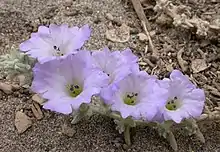Nolana
Nolana (Peruvian bell flower) is a genus of hard annual or perennial plants in the nightshade family. The genus is mostly native to Chile and Peru. Species in this genus, especially N. paradoxa, serve as a model system for studies on flower color.[1][2]
| Nolana | |
|---|---|
 | |
| Nolana confinis | |
| Scientific classification | |
| Kingdom: | Plantae |
| Clade: | Tracheophytes |
| Clade: | Angiosperms |
| Clade: | Eudicots |
| Clade: | Asterids |
| Order: | Solanales |
| Family: | Solanaceae |
| Subfamily: | Solanoideae |
| Tribe: | Nolaneae |
| Genus: | Nolana L.f. |
| Species | |
|
See text | |
Classification
There are a number of synonyms for Nolana: Alibrexia, Aplocarya, Bargemontia, Dolia, Gubleria, Leloutrea, Neudorfia, Osteocarpus, Pachysolen, Periloba, Rayera, Sorema, Teganium, Tula, Velpeaulia, Walberia, and Zwingera.
Nolana is the only genus in the Solanaceae which has a fruit composed of mericarps, although its flower and other vegetative morphology is similar to other plants in this family. It seems to be most closely related to Lycium and Grabowskia.[3]
Selected species
- Nolana acuminata
- Nolana atriplicifolia
- Nolana crassulifolia
- Nolana galapagensis
- Nolana humifusa
- Nolana prostrata
- Nolana rupicola
- Nolana sedifolia
- Nolana tenella
- Nolana paradoxa
References
- Stavenga, Doekele G.; Van Der Kooi, Casper J. (2016). "Coloration of the Chilean Bellflower, Nolana paradoxa, interpreted with a scattering and absorbing layer stack model". Planta. 243 (1): 171–181. doi:10.1007/s00425-015-2395-0. PMC 4698304. PMID 26369332.
- van der Kooi, Casper J.; Elzenga, J. Theo M.; Staal, Marten; Stavenga, Doekele G. (2016). "How to colour a flower: on the optical principles of flower coloration". Proceedings of the Royal Society B: Biological Sciences. 283 (1830). doi:10.1098/rspb.2016.0429. PMC 4874715. PMID 27170723.
- Dillon, M. O. (2005). "The Solanaceae of the lomas formations of coastal Peru and Chile" (PDF). Monographs in Systematic Botany: 131–56. S2CID 88507110. Archived from the original (PDF) on 2020-03-16.
- Dillon, M. O. and J. Wen. Phylogenetic Systematics of Nolana (Solanaceae) and Biogeographic Implications for the Atacama and Peruvian Deserts.
![]() Media related to Nolana at Wikimedia Commons
Media related to Nolana at Wikimedia Commons